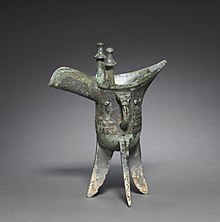Jue (vessel)

| Jue | |
|---|---|
Hanyu Pinyin | jué |
| Wade–Giles | chüeh2 |
| Middle Chinese | |
| Middle Chinese | t͡sɨɐk̚ |
| Old Chinese | |
| Zhengzhang | *ʔsewɢ |
A jue (
The vessel originated in Neolithic times as a pottery ware associated with the
Jue were the commonest type of vessel found in the tombs of elites during the Shang dynasty. Their ritual use is indicated by oracle bone inscriptions that suggest that they were used to heat and pour wine during oracular ceremonies in which the owner's ancestors and the Supreme Deity (Shangdi 上帝) were invoked. They were also used in temple ceremonies to mark particular festivals.[6] Traces of soot have been found on the legs and bottoms of a fewjue, indicating that some of them were placed directly into fires to heat their contents.[3] However, this appears in only about 5% of the jue excavated in archeological sites, so should be viewed as an exception rather than a rule.
According to the later Zhou-era Book of Etiquette and Ceremonial, it was used in formal settings with a prescribed set of ritual actions. After being lifted from its bamboo hamper, it was to be rinsed, lifted with one hand, emptied, set down and put back in its hamper. The drinker would praise the wine while the host would decline to do so, out of modesty. Similar rituals were conducted with the zhi (卮/巵/梔), another type of wine vessel. Analogous ceremonies are described in the Book of Rites, another Zhou text.[3]
References
- ^ ISBN 0670820474.
- ^ "Ritual Bronze Vessels". Ulrich Theobald. Retrieved 10 April 2020.
- ^ JSTOR 3249870.
- ^ "Jue". Britannica.com. Retrieved 4 April 2020.
- ^ "商 青銅爵 Wine Vessel (Jue) ca. 15th century B.C." Metropolitan Museum of Art. Retrieved 10 April 2020.
- ISBN 9781611460704.

